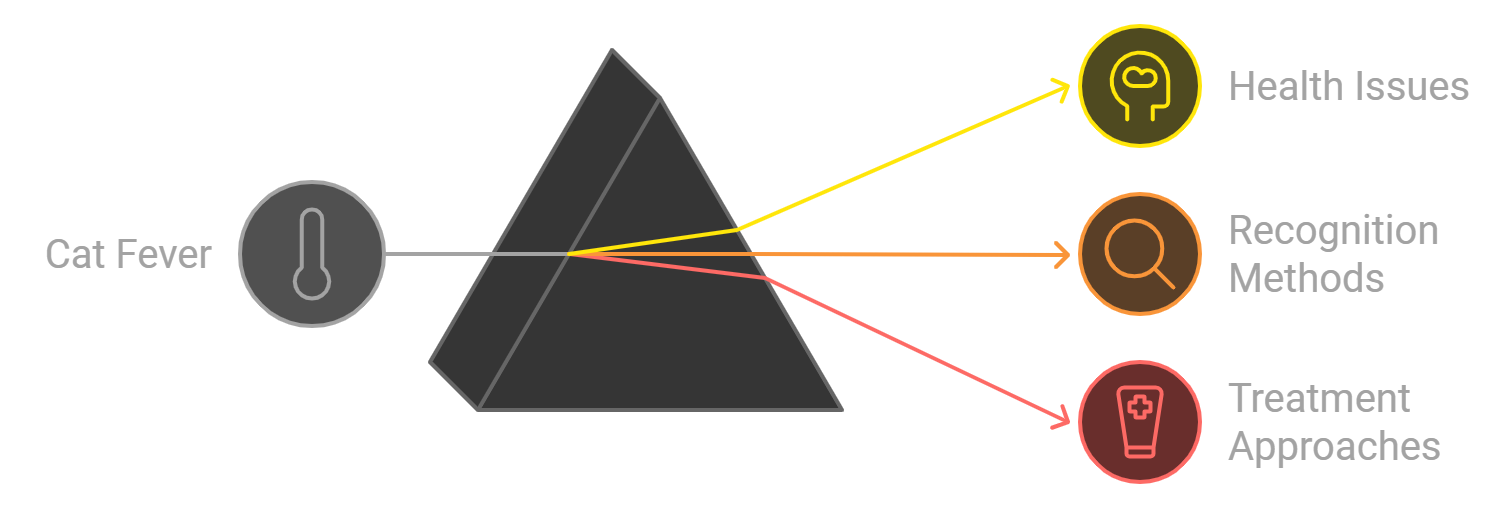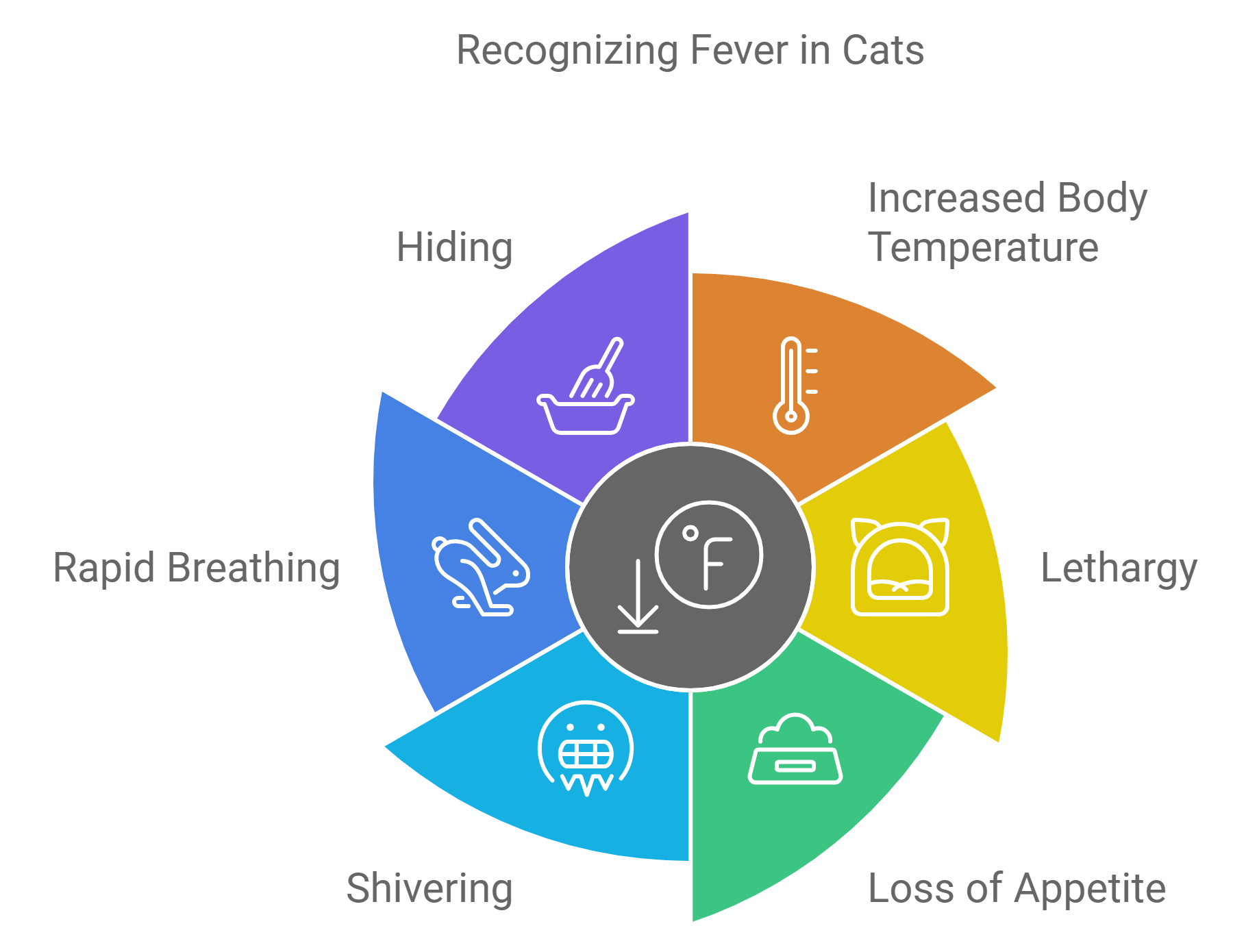When your cat is running a fever, it could indicate an underlying health problem needing urgent treatment. Sometimes, the fever is mild and may pass, but it can also become serious, suggesting a bigger medical condition.
It’s not always easy to tell when your cat is feverish, but noticing these small changes can help. A quick and thorough list of signs can guide you on how to respond in a crisis situation. Recognizing the common symptoms and knowing the right steps to take when they happen will ensure that you’re ready to act swiftly.

An Overview of Fever in Cats
How can you tell if your cat has a fever?
If you think your cat might have a fever, look for signs like a warm or dry nose, or if their body feels warmer than usual. While humans might use a kiss on the forehead to check temperature, this won’t work for animals. If your kitty’s temperature goes above 102.5ºF, it’s a sign of fever, and if it’s over 106ºF, it can cause damage to vital organs. Remember, temperatures below 103ºF aren’t always considered feverish.
For an accurate diagnosis, use a pediatric rectal or ear thermometer at home. Stay away from mercury thermometers as they can be harmful. Apply petroleum jelly to the thermometer and gently insert it for a correct reading. If you’re not comfortable doing this or find it uncomfortable for your cat, contact a vet right away.
Fevers can come from sickness, exercise, heat exhaustion, or stroke. Sometimes, excitement, pain, or reactions to medications may be the cause. A veterinarian can do a more thorough exam and run diagnostic testing if needed. If your cat shows unusual signs like being quiet or lethargic, it’s best to visit the vet to keep it healthy.
Causes of Fever in Cats
Fever in cats can be a worrying sign for any pet owner. When a cat’s immune system gets activated, it responds to various conditions that could lead to fevers. This activation can occur due to many underlying causes, ranging from infections to environmental factors. As a cat owner, understanding these potential causes can help you take action when your furry friend is not feeling well.

Main Causes of Fever in Cats
- Infections: Both bacterial, viral, and fungal infections are common triggers of fever in cats. These infections can affect almost any organ in the body, leading to serious health issues. Parasitic infections, like Cytauxzoonosis (also known as bobcat fever), a tick-borne disease caused by the Cytauxzoon felis parasite, are particularly dangerous for outdoor cats. Haemobartonellosis and Ehrlichiosis are other bacterial blood infections that can cause fever.
- Injury or Trauma: A cat’s injury or trauma can also result in fever as the body reacts to damage. Whether it’s a minor cut or a significant injury, the body’s immune system kicks into high gear, sometimes causing a fever in the process.
- Medications and Diseases: Certain medications can have a side effect of fever. Similarly, tumors, immune-mediated diseases, and chronic conditions like lupus can trigger fever. These are typically more challenging to detect without the help of a vet.
- Environmental Factors: Exposure to a warm environment or increased muscle activity can cause hyperthermia, a rise in body temperature. However, fever differs from hyperthermia because it is a regulated increase in temperature controlled by the hypothalamus in the brain, acting as the body’s thermostat.
- Reproductive and Other Health Conditions: Specific conditions such as milk fever (Eclampsia), which occurs after giving birth, can also lead to fever. Additionally, complications like abortion in cats or infections after birth can further contribute to the development of fever.
Tick-borne and Parasitic Diseases

Tick-borne illnesses, especially for outdoor cats, are a frequent cause of fever. Diseases like bobcat fever and Ehrlichiosis are passed through ticks, often leading to symptoms like lethargy, swollen lymph nodes, and high fever. Cats affected by these diseases may experience a range of additional symptoms, including depression, coughing, and in severe cases, blindness.
By recognizing these common causes, you can act quickly if your cat starts showing signs of illness, especially if they are an outdoor cat with a higher risk of exposure.
Signs of Fever in Cats

Lethargy and Reduced Energy
When a cat may be dehydrated or feverish, you’ll notice it becoming more lethargic than usual. They often sleep more and avoid activities they normally enjoy, showing a lack of energy or interest in play.
Loss of Appetite
A cat not eating is a serious sign. Reduced appetite can be linked to fever, and they might hide to conserve energy. If this is paired with vomiting or diarrhea in cats, it’s time to consider a veterinarian appointment.
Warm Ears and Body Temperature
One of the first signs of fever in cats is warm ears. A cat’s body temperature rises during a fever, and the ears can feel warmer than normal, even on a hot day. Feel the inside and outside of the ears to check for this sign.
Glassy Eyes and Weakness
Glassy eyes are a common symptom of fever in both cats and humans. When a cat’s eyes look glassy, watery, or sunken, it’s a signal that they might be sick, often from fever or dehydration.
Diarrhea and Dehydration
Diarrhea in cats can be a worrisome symptom that causes fever. This symptom, along with decreased drinking, can mean the cat may be dehydrated. If these signs appear, it’s crucial to visit the vet.
Important Tips to Manage Fever in Cats (Final Takeaway)
- Never give a cat human medications like acetaminophen, as it is toxic and can be fatal to cats. Always follow the explicit advice of your veterinarian when treating a cat with fever.
- Ensure your cat stays hydrated by offering fresh clean water and keeping them in a comfortable place to relax. If the fever lasts longer than 24 hours or exceeds 106º F, it’s important to contact your vet or schedule an urgent appointment with a local emergency animal hospital for a full examination.
- If a bacterial infection is determined to be the source of the fever, your vet may prescribe antibiotics for cats to help restore their health. In some cases, the cause of the fever may not be immediately evident, and your cat could be diagnosed with a fever of unknown origin (FUO), requiring additional tests and treatment.
- For moderate to severe dehydration, your cat may need intravenous or subcutaneous fluids to help them feel better and fight off illness. In cases of high fever, especially if your cat isn’t eating or drinking, they may require nutritional support, hospitalization, and close monitoring with injectable medications and IV fluids to aid their recovery.
FAQs
How do you tell if a cat has a fever?
To know if your cat has a fever, watch for signs like loss of appetite, depression, and a lack of energy or activity. Other common symptoms include decreased drinking, hiding, poor grooming, and physical signs like shivering or rapid breathing.
How to treat a cat with a fever?
To help a cat with a fever, keep them hydrated and use a damp cloth on their paws, nose, and ears. Make sure they rest in a fresh room, and never use over-the-counter medication to reduce their fever.
Do cats feel warm to the touch when they have a fever?
If your cat has a high temperature, they may feel hot to the touch and seem unwell, with low energy. They might also be eating less and drinking less, which could indicate more serious conditions.
Does cat fever go away on its own?
Some cat fevers can go away on their own, especially if it’s a mild upper respiratory infection, which usually returns to normal in about a week. However, if you have any doubt, it’s important to consult your veterinarian, as fevers can signal a life-threatening health problem.

